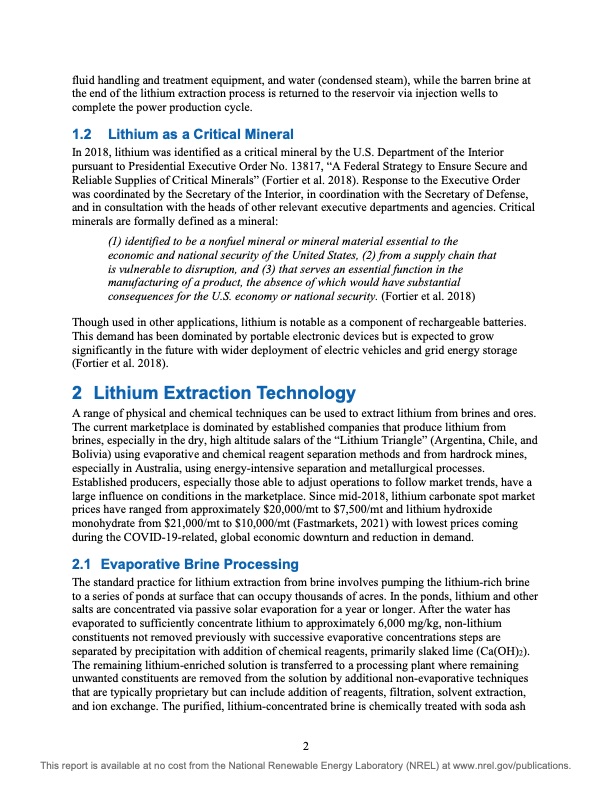
PDF Publication Title:
Text from PDF Page: 011
fluid handling and treatment equipment, and water (condensed steam), while the barren brine at the end of the lithium extraction process is returned to the reservoir via injection wells to complete the power production cycle. 1.2 Lithium as a Critical Mineral In 2018, lithium was identified as a critical mineral by the U.S. Department of the Interior pursuant to Presidential Executive Order No. 13817, “A Federal Strategy to Ensure Secure and Reliable Supplies of Critical Minerals” (Fortier et al. 2018). Response to the Executive Order was coordinated by the Secretary of the Interior, in coordination with the Secretary of Defense, and in consultation with the heads of other relevant executive departments and agencies. Critical minerals are formally defined as a mineral: (1) identified to be a nonfuel mineral or mineral material essential to the economic and national security of the United States, (2) from a supply chain that is vulnerable to disruption, and (3) that serves an essential function in the manufacturing of a product, the absence of which would have substantial consequences for the U.S. economy or national security. (Fortier et al. 2018) Though used in other applications, lithium is notable as a component of rechargeable batteries. This demand has been dominated by portable electronic devices but is expected to grow significantly in the future with wider deployment of electric vehicles and grid energy storage (Fortier et al. 2018). 2 LithiumExtractionTechnology A range of physical and chemical techniques can be used to extract lithium from brines and ores. The current marketplace is dominated by established companies that produce lithium from brines, especially in the dry, high altitude salars of the “Lithium Triangle” (Argentina, Chile, and Bolivia) using evaporative and chemical reagent separation methods and from hardrock mines, especially in Australia, using energy-intensive separation and metallurgical processes. Established producers, especially those able to adjust operations to follow market trends, have a large influence on conditions in the marketplace. Since mid-2018, lithium carbonate spot market prices have ranged from approximately $20,000/mt to $7,500/mt and lithium hydroxide monohydrate from $21,000/mt to $10,000/mt (Fastmarkets, 2021) with lowest prices coming during the COVID-19-related, global economic downturn and reduction in demand. 2.1 EvaporativeBrineProcessing The standard practice for lithium extraction from brine involves pumping the lithium-rich brine to a series of ponds at surface that can occupy thousands of acres. In the ponds, lithium and other salts are concentrated via passive solar evaporation for a year or longer. After the water has evaporated to sufficiently concentrate lithium to approximately 6,000 mg/kg, non-lithium constituents not removed previously with successive evaporative concentrations steps are separated by precipitation with addition of chemical reagents, primarily slaked lime (Ca(OH)2). The remaining lithium-enriched solution is transferred to a processing plant where remaining unwanted constituents are removed from the solution by additional non-evaporative techniques that are typically proprietary but can include addition of reagents, filtration, solvent extraction, and ion exchange. The purified, lithium-concentrated brine is chemically treated with soda ash 2 This report is available at no cost from the National Renewable Energy Laboratory (NREL) at www.nrel.gov/publications.PDF Image | Lithium Extraction from Geothermal Brines

PDF Search Title:
Lithium Extraction from Geothermal BrinesOriginal File Name Searched:
79178.pdfDIY PDF Search: Google It | Yahoo | Bing
Product and Development Focus for Infinity Turbine
ORC Waste Heat Turbine and ORC System Build Plans: All turbine plans are $10,000 each. This allows you to build a system and then consider licensing for production after you have completed and tested a unit.Redox Flow Battery Technology: With the advent of the new USA tax credits for producing and selling batteries ($35/kW) we are focussing on a simple flow battery using shipping containers as the modular electrolyte storage units with tax credits up to $140,000 per system. Our main focus is on the salt battery. This battery can be used for both thermal and electrical storage applications. We call it the Cogeneration Battery or Cogen Battery. One project is converting salt (brine) based water conditioners to simultaneously produce power. In addition, there are many opportunities to extract Lithium from brine (salt lakes, groundwater, and producer water).Salt water or brine are huge sources for lithium. Most of the worlds lithium is acquired from a brine source. It's even in seawater in a low concentration. Brine is also a byproduct of huge powerplants, which can now use that as an electrolyte and a huge flow battery (which allows storage at the source).We welcome any business and equipment inquiries, as well as licensing our turbines for manufacturing.| CONTACT TEL: 608-238-6001 Email: greg@infinityturbine.com | RSS | AMP |